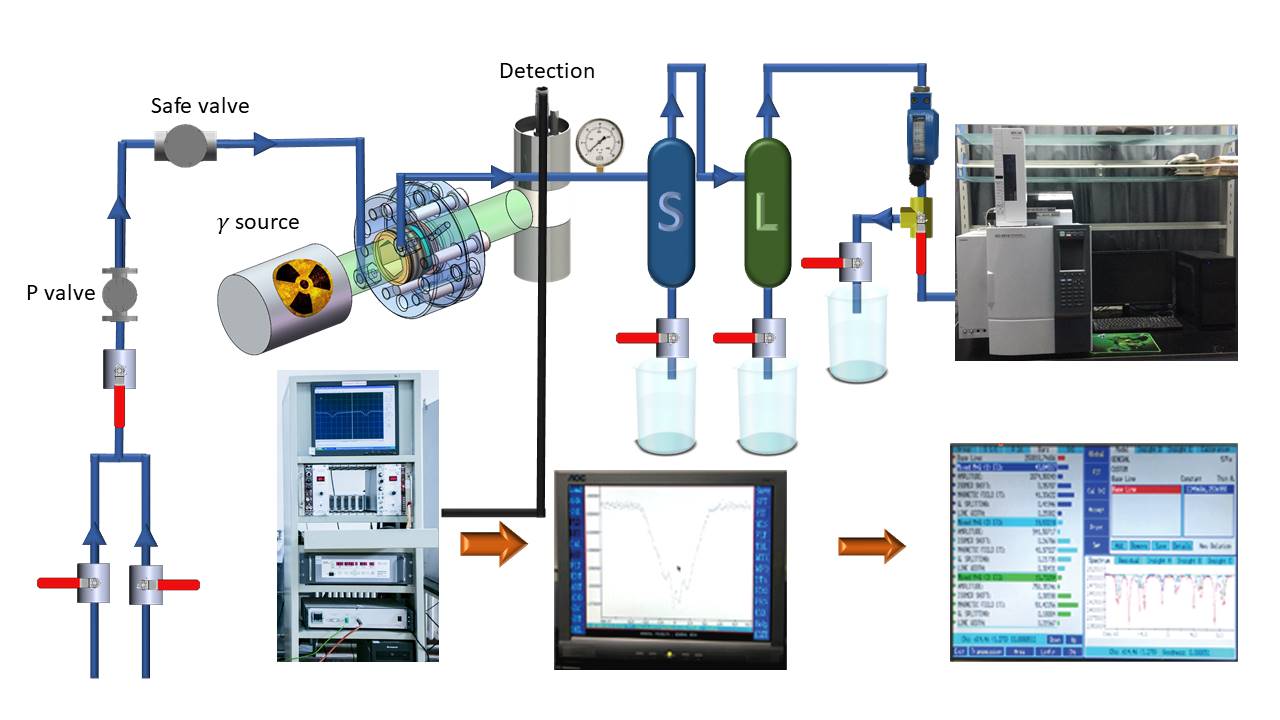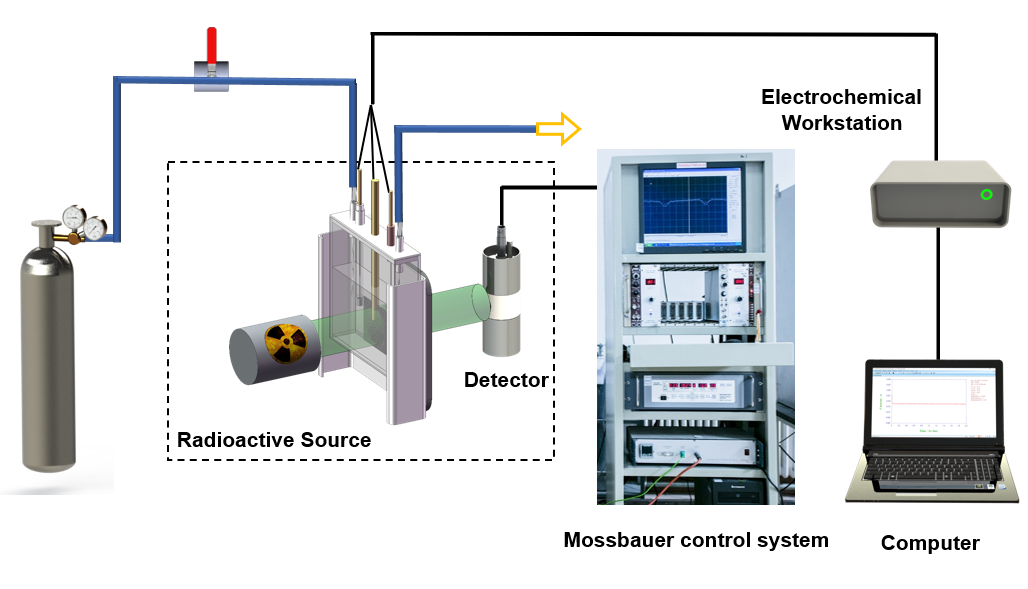◆ Mössbauer Spectroscopic Characterization
1. General Introduction
Center for Advanced Mössbauer Spectroscopy has several sets of advanced 57Fe and 119Sn Mössbauer spectrometers, which can dynamically track the state changes of Mössbauer nuclides in functional materials under various in-situ/operando conditions.
The low temperature Mössbauer measurements use Janis continuous flow cryostat system, which can realize variable temperature observation from 4.2K to room temperature and even above.
Equipped with 57Fe and 119Sn internal conversion electron Mössbauer spectra (CEMS) detectors, the surface properties of functional materials can be studied with selected surface thickness.
Management and operation of the Mössbauer Effect Data Center (MEDC), which is responsible for the publication of Mössbauer Effect Reference and Data Journal (MERDJ) and the development and maintenance of the world's largest MEDC database. The MERDJ and Database of the MEDC are online open world wide, which can directly provide information support for the fitting and analysis of the measured Mössbauer spectra.
Our services include not only Mössbauer spectral measurements, but also professional Mössbauer spectral fitting and analytical results discussion. We aim to provide worldwide first-class Mössbauer spectral application research resources to the users around the world. Through extensive international and domestic cooperation and exchanges, cultivate more young scholars engaged in the applications of the Mössbauer spectral studies.
2. Features of Mössbauer Spectrometer
1) Ultra low vibration (standard iron foil's spectral line width is less than 0.28mm/s)
2) Ultra high energy resolution (10-8eV)
3) Big various temperature range: room temperature, low temperature (4.2 - 300K) and high temperature (300-1273K)
4) Transmission and internal conversion electron double modes
5) In-situ/operando characterizations (various redox atmospheres, temperature, pressure, light irradiation, thermal catalysis, photocatalysis, electrocatalysis, battery, external magnetic field, etc.)
6) Professional Mössbauer spectral fitting software
7) Multiple radiation safety protection
3. Application Fields
Mössbauer spectroscopy is to study the electron behavior outside the nucleus by observing the resonance absorption phenomenon of the nucleus to gamma rays. It has been widely used in many research fields such as material structure, chemical bond, magnetism, in-situ state analysis and so on. The hyperfine structure of Mössbauer spectra is very sensitive to chemical, structural and magnetic changes of Mössbauer nuclides. In addition to solid samples, liquid samples can also be measured by rapid freezing. In the study of heterogeneous catalysis, the structure-activity relationship between active phase and catalytic properties and its catalytic mechanism, the possible activation or inactivation process of the catalyst in the catalytic reaction, and the chemical adsorption behavior of the reactants or molecular probes can be directly discussed by means of Mössbauer characterization.
Examples of our services:
1) Room temperature transmission 57Fe and 119Sn Mössbauer spectral characterizations
2) Room temperature 57Fe and1 19Sn CEMS characterizations
3) Low temperature and variable temperature 57Fe and 119Sn Mössbauer spectral characterizations
4) High temperature and variable temperature 57Fe and 119Sn Mössbauer spectral characterizations
5) High temperature, high pressure and atmospherecontrol in-situ/operando 57Fe and 119Sn Mössbauer spectral characterizations to various ironor tin-based catalysts such as Fischer-tropsch synthesis, carbon dioxide hydrogenation, ammonia synthesis and decomposition under working conditions
6) Electrochemical in-situ/operando 57Fe and 119Sn Mössbauer spectral characterizations to various iron or tin-based catalysts such as electrolysis water for hydrogen production, electrocatalytic reduction of carbon dioxide under working conditions
7) Ion battery in-situ/operando 57Fe and 119Sn Mössbauer spectral characterizations
8) Photocatalytic in-situ/operando 57Fe and 119Sn Mössbauer spectral characterization
9) Vacuum frozen solution variable temperature 57Fe and 119Sn Mössbauer spectral characterizations
10) Unstable samples 57Fe and 119Sn Mössbauer spectral characterizations (sample preparation in glove box atmosphere protection, in-situ/operando atmosphere control characterization, etc.
11) Low temperature 57Fe and 119Sn Mössbauer spectral characterizations with external magnetic field (completed with international collaborators)
12) 151Eu,121Sb, 197Au Mössbauer spectral characterizations (completed with international collaborators)

Fig. 1 schematic diagram of in-situ/operando thermocatalytic Mössbauer spectral characterization instrument

Fig. 2 schematic diagram of in-situ/operando Mössbauer spectral characterization instrument for high temperature, high pressure and atmosphere control catalytic reactions

Fig. 3 schematic diagram of in-situ/operando electrocatalytic Mössbauer spectral characterization instrument
4. Reservation
Before making reservation, please first contact us (Email: mossbauer@dicp.ac.cn, Tel: +86-411-84379711).
5. Sample Requirements
The sample should be solid powder, and the recommended absorption thickness of iron/tin in the sample is about 10mg/cm2. The sample amount can be calculated according to the formula of 10mg/cm2 dividing by the percentage of iron/tin in the sample.
All kinds of samples containing Mössbauer nuclides, mainly iron and tin, can be characterized by Mössbauer spectroscopy. Solid samples with very low iron content, as well as frozen solution samples, often require the use of enriched isotopes, such as the precursor of 57Fe, to prepare samples. We can provide 57Fe enriched isotopes in metallic state to the customers so as to shorten the testing time and improve the signal-to-noise ratio of spectra.
6. Others
In addition to the above advanced Mössbauer spectral characterizations, we also have a variety of instruments and devices for the synthesis and characterization of thermocatalysis, photocatalysis and electrocatalysis materials.
◆ MEDC Database Searching
MEDC Database: http://medcdb.dicp.ac.cn/
MEDC Planetary Database: http://medcdb.dicp.ac.cn/wadetm/
Mössbauer Effect Data Center Database(MEDC-DB)is the world's largest Mössbauer literature and database, covering all fields of Mössbauer related literatures and data information, has collected more than 60,000 Mössbauer related published literatures, more than 115,000 Mössbauer related data records. In 2018, as an important part of the further development of Mösbauer Effect Data Center (MEDC), the online access interface of the Database has been upgraded from "4D" to "MEDC-DEM" in database management system, which has improved the functionality and accuracy of the Database.
In the scientific database research of spectroscopy, although parameterization can promote the dissemination of data and the use of this technique, there is no better way to record the experimental data of transmission than the visual spectrum itself. MEDC is in the process of redeveloping the existing database, and will use a new synchronous concept to design the database management system to realize the concept of co-building the database by staff, international partners and users. It is not only necessary to record the literature data information related to Mössbauer spectrum, but also to add the experimental spectrum and its fitting analysis results, so as to improve the integrity of the record inheritance of Mössbauer spectrum experimental data, so that it can meet the high standards and high requirements of modern scientific database to the maximum extent.
◆ Mössbauer Effect Reference and Data Journal
Mössbauer Effect Reference and Data Journal (new version): http://merdj.dicp.ac.cn/
Mössbauer Effect Reference and Data Journal(old version): http://www.medc.dicp.ac.cn/Journal.htm
Mössbauer Effect Reference and Data Journal (MERDJ, ISSN 0163-9587) is the core journal of international Mössbauer spectroscopy information exchange, which is published and distributed Mössbauer Effect Data Center(MEDC, http://www.medc.dicp.ac.cn/)since 2010. MERDJ has a history of nearly 50 years, and enjoys a high reputation in the field of Mössbauer spectroscopy. It publishes ten issues each year, mainly publishing two parts of new literature, data information and newsletters related to Mössbauer spectroscopy. Since September 2010, volume 33, number 6 of MERDJ edits by MEDC director Tao Zhang and MEDC Secretary General Junhu Wang. The editorial board of MERDJ is composed of more than 30 well-known Mössbauer spectroscopy related scientists from more than 20 countries.
◆ Mössbauer Spectroscopy Newsletter
Mössbauer Effect Reference and Data Journal (MERDJ) Featured Papers Reading
◆ Technical Consultant for Mössbauer Source, Software and Instrument
The Center for Advanced Mössbauer Spectroscopy is authorized to provide the following technical consultant services:
1) Russian Ritverc Mössbauer radioactive sources manufacture (http://www.ritverc.com/)
2) Moswinn spectral fitting software (http://www.mosswinn.com/english/index.html)
3) WissEl Mössbauer instruments manufacture (http://www.wissel-Instruments.de/)
◆ Contacts
Tel: + 86-411-84379711
Email: mossbauer@dicp.ac.cn
Add: Dalian Institute of Chemical Physics, Chinese Academy of Sciences, 457 Zhongshan Road, Dalian 116023, China